您好,登錄后才能下訂單哦!
您好,登錄后才能下訂單哦!
這篇文章給大家分享的是有關如何通過selenium抓取某東的TT購買記錄并分析趨勢的內容。小編覺得挺實用的,因此分享給大家做個參考,一起跟隨小編過來看看吧。
本文通過selenium抓取TT信息,存入到mongodb數據庫中。
抓取TT產品信息
TT產品頁面的連接是
https://list.jd.com/list.html?cat=9192,9196,1502&page=1&sort=sort_totalsales15_desc&trans=1&JL=6_0_0#J_main
上面有個page參數,表示第幾頁。改變這個參數就可以爬取到不同頁面的TT產品。
通過開發者工具看下如果抓取TT的產品信息,例如名字、品牌、價格、評論數量等。
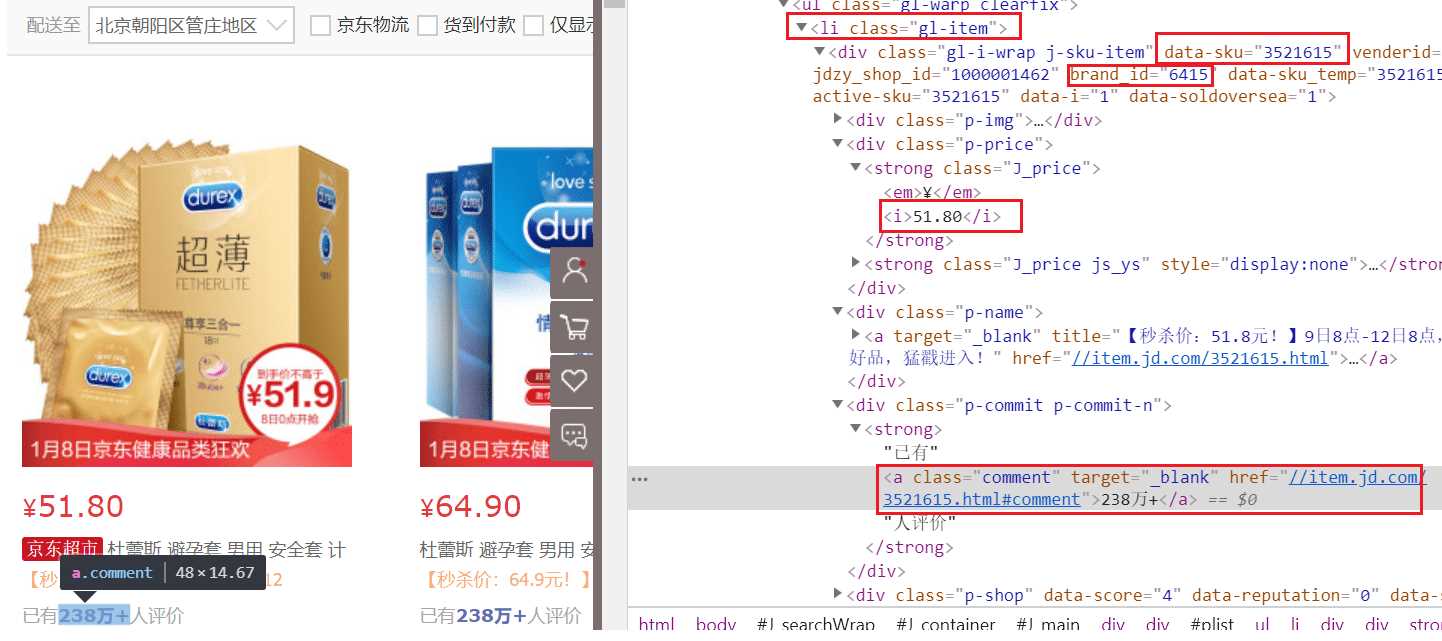
通過上圖可以看到一個TT產品信息對應的源代碼是一個class為gl-item的li節點<li class='gl-item'>。li節點中data-sku屬性是產品的ID,后面抓取產品的評論信息會用到,brand_id是品牌ID。class為p-price的div節點對應的是TT產品的價格信息。class為p-comment的div節點對應的是評論總數信息。
開始使用requests是總是無法解析到TT的價格和評論信息,最后適應selenium才解決了這個問題,如果有人知道怎么解決這問題,望不吝賜教。
下面介紹抓取TT產品評論信息。
點擊一個TT產品,會跳轉到產品詳細頁面,點擊“商品評論”,然后勾選上“只看當前商品評價”選項(如果不勾選,就會看到該系列產品的評價)就會看到商品評論信息,我們用開發者工具看下如果抓取評論信息。
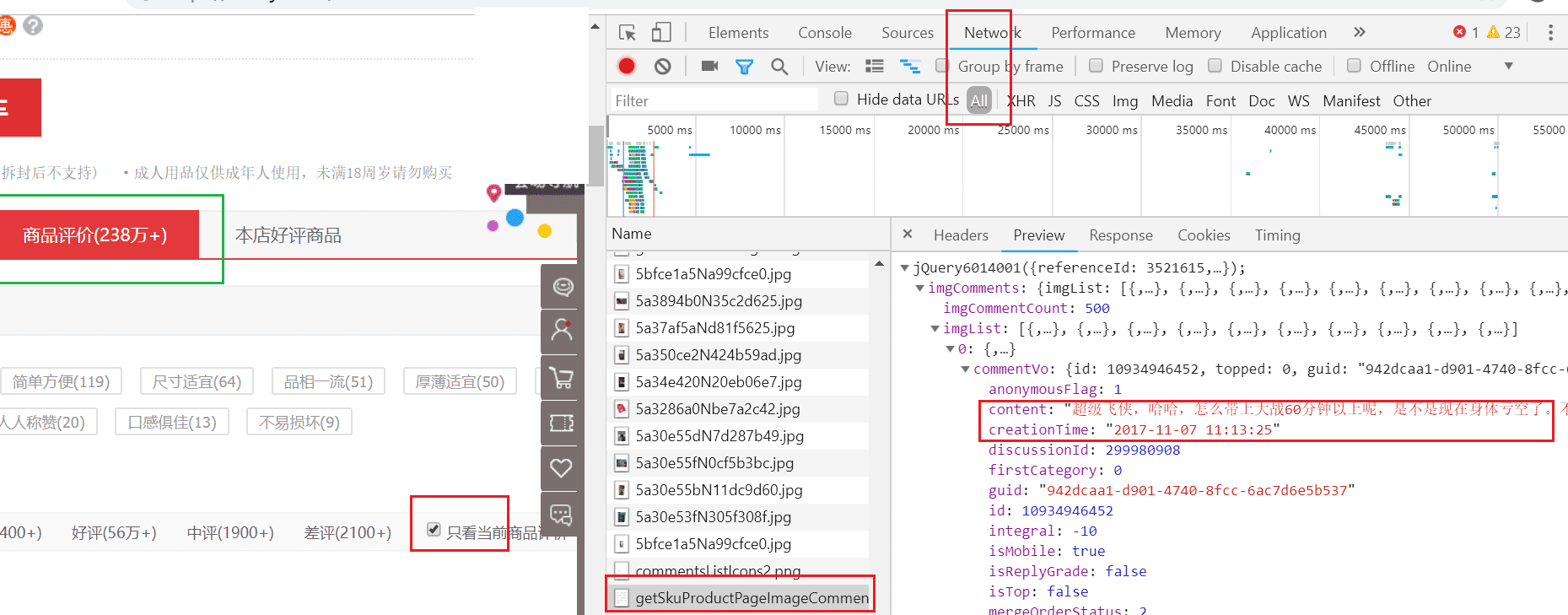
如上圖所示,在開發者工具中,點擊Network選項,就會看到
https://club.jd.com/discussion/getSkuProductPageImageCommentList.action?productId=3521615&isShadowSku=0&callback=jQuery6014001&page=2&pageSize=10&_=1547042223100
的鏈接,這個鏈接返回的是json數據。其中productId就是TT產品頁面的data-sku屬性的數據。page參數是第幾頁評論。返回的json數據中,content是評論數,createTime是下單時間。
代碼如下:
def parse_product(page,html):
doc = pq(html)
li_list = doc('.gl-item').items()
for li in li_list:
product_id = li('.gl-i-wrap').attr('data-sku')
brand_id = li('.gl-i-wrap').attr('brand_id')
time.sleep(get_random_time())
title = li('.p-name').find('em').text()
price_items = li('.p-price').find('.J_price').find('i').items()
price = 0
for price_item in price_items:
price = price_item.text()
break
total_comment_num = li('.p-commit').find('strong a').text()
if total_comment_num.endswith("萬+"):
print('總評價數量:' + total_comment_num)
total_comment_num = str(int(float(total_comment_num[0:len(total_comment_num) -2]) * 10000))
print('轉換后總評價數量:' + total_comment_num)
elif total_comment_num.endswith("+"):
total_comment_num = total_comment_num[0:len(total_comment_num) - 1]
condom = {}
condom["product_id"] = product_id
condom["brand_id"] = brand_id
condom["condom_name"] = title
condom["total_comment_num"] = total_comment_num
condom["price"] = price
comment_url = 'https://club.jd.com/comment/skuProductPageComments.action?callback=fetchJSON_comment98vv117396&productId=%s&score=0&sortType=5&page=0&pageSize=10&isShadowSku=0&fold=1'
comment_url = comment_url %(product_id)
response = requests.get(comment_url,headers = headers)
if response.text == '':
for i in range(0,10):
time.sleep(get_random_time())
try:
response = requests.get(comment_url, headers=headers)
except requests.exceptions.ProxyError:
time.sleep(get_random_time())
response = requests.get(comment_url, headers=headers)
if response.text:
break
else:
continue
text = response.text
text = text[28:len(text) - 2]
jsons = json.loads(text)
productCommentSummary = jsons.get('productCommentSummary')
# productCommentSummary = response.json().get('productCommentSummary')
poor_count = productCommentSummary.get('poorCount')
general_count = productCommentSummary.get('generalCount')
good_count = productCommentSummary.get('goodCount')
comment_count = productCommentSummary.get('commentCount')
poor_rate = productCommentSummary.get('poorRate')
good_rate = productCommentSummary.get('goodRate')
general_rate = productCommentSummary.get('generalRate')
default_good_count = productCommentSummary.get('defaultGoodCount')
condom["poor_count"] = poor_count
condom["general_count"] = general_count
condom["good_count"] = good_count
condom["comment_count"] = comment_count
condom["poor_rate"] = poor_rate
condom["good_rate"] = good_rate
condom["general_rate"] = general_rate
condom["default_good_count"] = default_good_count
collection.insert(condom)
comments = jsons.get('comments')
if comments:
for comment in comments:
print('解析評論')
condom_comment = {}
reference_time = comment.get('referenceTime')
content = comment.get('content')
product_color = comment.get('productColor')
user_client_show = comment.get('userClientShow')
user_level_name = comment.get('userLevelName')
is_mobile = comment.get('isMobile')
creation_time = comment.get('creationTime')
guid = comment.get("guid")
condom_comment["reference_time"] = reference_time
condom_comment["content"] = content
condom_comment["product_color"] = product_color
condom_comment["user_client_show"] = user_client_show
condom_comment["user_level_name"] = user_level_name
condom_comment["is_mobile"] = is_mobile
condom_comment["creation_time"] = creation_time
condom_comment["guid"] = guid
collection_comment.insert(condom_comment)
parse_comment(product_id)
def parse_comment(product_id):
comment_url = 'https://club.jd.com/comment/skuProductPageComments.action?callback=fetchJSON_comment98vv117396&productId=%s&score=0&sortType=5&page=%d&pageSize=10&isShadowSku=0&fold=1'
for i in range(1,200):
time.sleep(get_random_time())
time.sleep(get_random_time())
print('抓取第' + str(i) + '頁評論')
url = comment_url%(product_id,i)
response = requests.get(url, headers=headers,timeout=10)
print(response.status_code)
if response.text == '':
for i in range(0,10):
print('抓取不到數據')
response = requests.get(comment_url, headers=headers)
if response.text:
break
else:
continue
text = response.text
print(text)
text = text[28:len(text) - 2]
print(text)
jsons = json.loads(text)
comments = jsons.get('comments')
if comments:
for comment in comments:
print('解析評論')
condom_comment = {}
reference_time = comment.get('referenceTime')
content = comment.get('content')
product_color = comment.get('productColor')
user_client_show = comment.get('userClientShow')
user_level_name = comment.get('userLevelName')
is_mobile = comment.get('isMobile')
creation_time = comment.get('creationTime')
guid = comment.get("guid")
id = comment.get("id")
condom_comment["reference_time"] = reference_time
condom_comment["content"] = content
condom_comment["product_color"] = product_color
condom_comment["user_client_show"] = user_client_show
condom_comment["user_level_name"] = user_level_name
condom_comment["is_mobile"] = is_mobile
condom_comment["creation_time"] = creation_time
condom_comment["guid"] = guid
condom_comment["id"] = id
collection_comment.insert(condom_comment)
else:
break如果想要獲取抓取TT數據和評論的代碼,請關注我的公眾號“python_ai_bigdata”,然后恢復TT獲取代碼。
一共抓取了8934條產品信息和17萬條評論(購買)記錄。
產品最多的品牌
先分析8934個產品,看下哪個品牌的TT在京東上賣得最多。由于品牌過多,京東上銷售TT的品牌就有299個,我們只取賣得最多的前10個品牌。
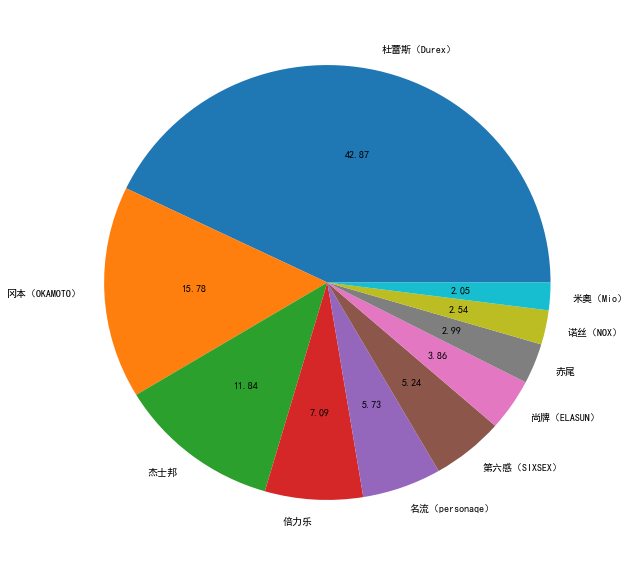
從上面的圖可以看出,排名第1的是杜杜,岡本次之,邦邦第3,前10品牌分別是杜蕾斯、岡本、杰士邦、倍力樂、名流、第六感、尚牌、赤尾、諾絲和米奧。這10個品牌中有5個是我沒見過的,分別是倍力樂、名流、尚牌、赤尾和米奧,其他的都見過,特別是杜杜和邦邦常年占據各大超市收銀臺的醒目位置。
這10個品牌中,杜蕾斯來自英國,岡本來自日本,杰士邦、第六感、赤尾、米奧和名流是國產的品牌,第六感是杰士邦旗下的一個避孕套品牌;倍力樂是中美合資的品牌,尚牌來自泰國,諾絲是來自美國的品牌。
代碼:
import pymongo
import pandas as pd
import numpy as np
import matplotlib.pyplot as plt
from pandas import DataFrame,Series
client = pymongo.MongoClient(host='localhost',port=27017)
db = client.condomdb
condom_new = db.condom_new
cursor = condom_new.find()
condom_df = pd.DataFrame(list(cursor))
brand_name_df = condom_df['brand_name'].to_frame()
brand_name_df['condom_num'] = 1
brand_name_group = brand_name_df.groupby('brand_name').sum()
brand_name_sort = brand_name_group.sort_values(by='condom_num', ascending=False)
brand_name_top10 = brand_name_sort.head(10)
# print(3 * np.random.rand(4))
index_list = []
labels = []
value_list = []
for index,row in brand_name_top10.iterrows():
index_list.append(index)
labels.append(index)
value_list.append(int(row['condom_num']))
plt.rcParams['font.sans-serif']=['SimHei'] #用來正常顯示中文標簽
plt.rcParams['axes.unicode_minus']=False #用來正常顯示負號
series_condom = pd.Series(value_list, index=index_list, name='')
series_condom.plot.pie(labels=labels,
autopct='%.2f', fontsize=10, figsize=(10, 10))賣得最好的產品
可以根據產品評價數量來判斷一個產品賣得好壞,評價數最多的產品通常也是賣得最好的。
產品評論中有個產品評論總數的字段,我們就根據這個字段來排序,看下評論數量最多的前10個產品是什么(也就是評論數量最多的)。
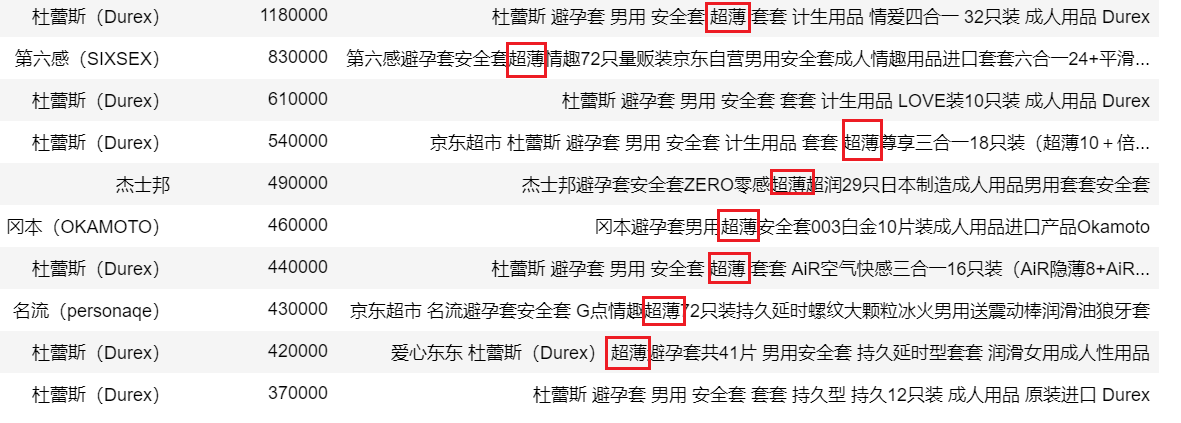
從上圖可以看出,賣得最好的還是杜杜的產品,10席中占了6席。杜杜的情愛四合一以1180000萬的銷量排名第一。
最受歡迎的是超薄的TT,占了8席,持久型的也比較受歡迎,狼牙套竟然也上榜了,真是大大的出乎我的意料。
銷量分析
下圖是TT銷量最好的10天
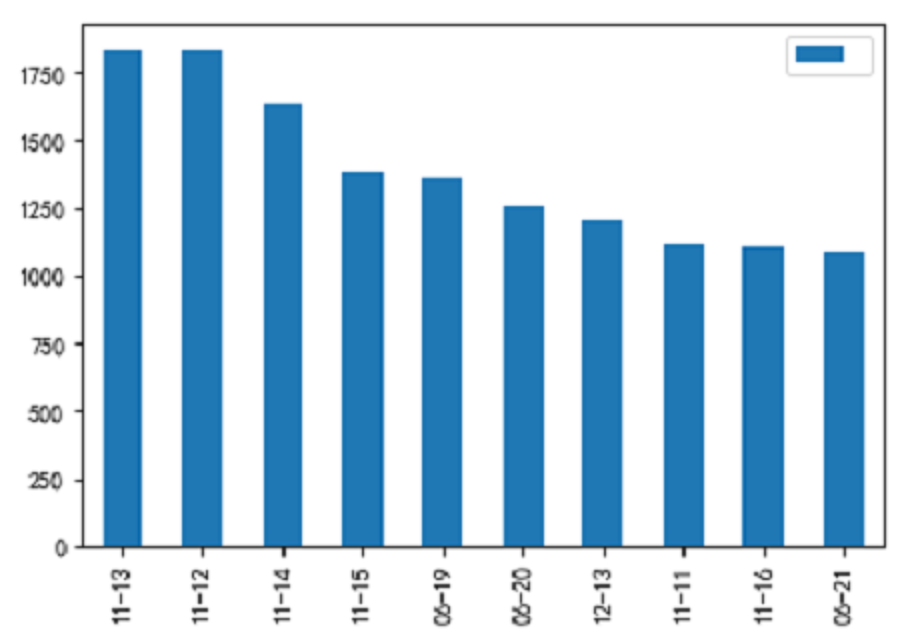
可以看出這10天分別分布在6月、11月和12月,應該和我們熟知的618、雙11和雙12購物節有關。
現在很多電商都有自己的購物節,像618,雙11和雙12。由于一個產品最多只能顯示100頁的評論,每頁10條評論,一個產品最多只能爬取到1000條評論,對于銷量達到118萬的情愛四合一來說,1000條評論不具有代表性,但是總的來說通過上圖的分析,可以知道電商做活動的月份銷量一般比較好。
下圖是每個月份TT銷售量柱狀圖,更加驗證了上面的說法。
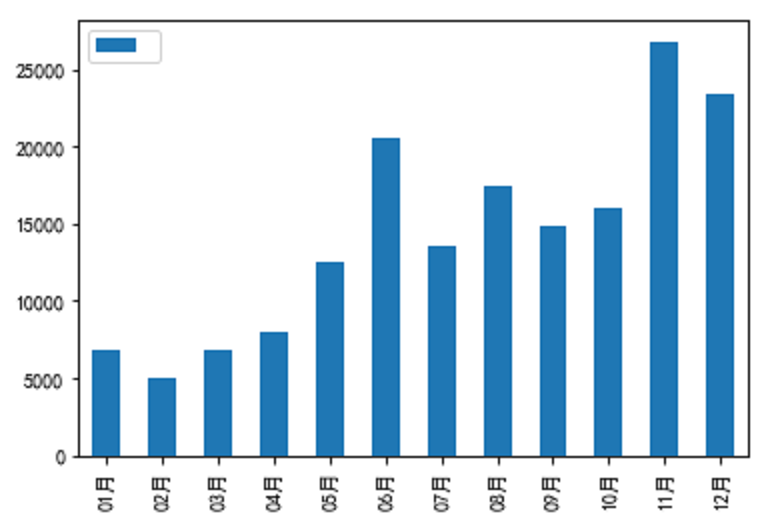
11月的銷量最好,12月次之,6月份的銷量第三。
購物平臺
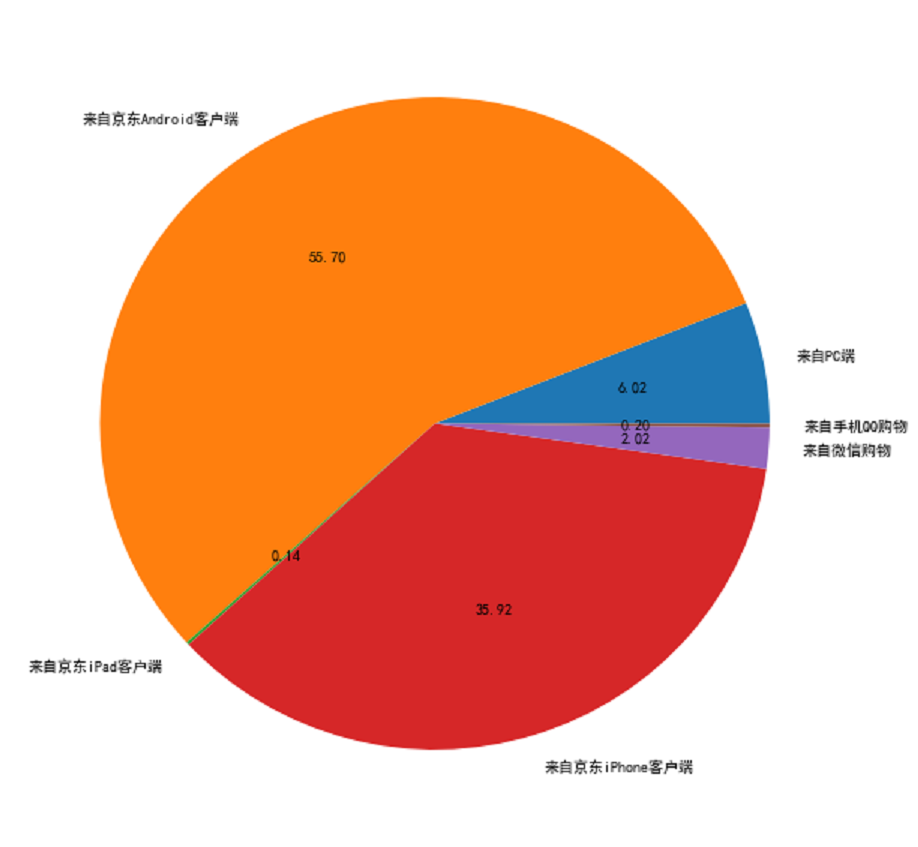
通過京東app購買TT的最多,91%的用戶來自京東Android客戶端和iphone客戶端。6%的用戶來自PC端,這幾年4G的發展有關。
通過上面的分析可以知道,超薄的TT最受歡迎。杜杜的產品賣得最好,這和他們的營銷方案有關,杜杜的文案可以稱作教科書級的,每次發布文案都引起大家的討論,堪稱個個經典。移動客戶端購買TT已經成為主流,占據90%以上的流量。
感謝各位的閱讀!關于“如何通過selenium抓取某東的TT購買記錄并分析趨勢”這篇文章就分享到這里了,希望以上內容可以對大家有一定的幫助,讓大家可以學到更多知識,如果覺得文章不錯,可以把它分享出去讓更多的人看到吧!
免責聲明:本站發布的內容(圖片、視頻和文字)以原創、轉載和分享為主,文章觀點不代表本網站立場,如果涉及侵權請聯系站長郵箱:is@yisu.com進行舉報,并提供相關證據,一經查實,將立刻刪除涉嫌侵權內容。